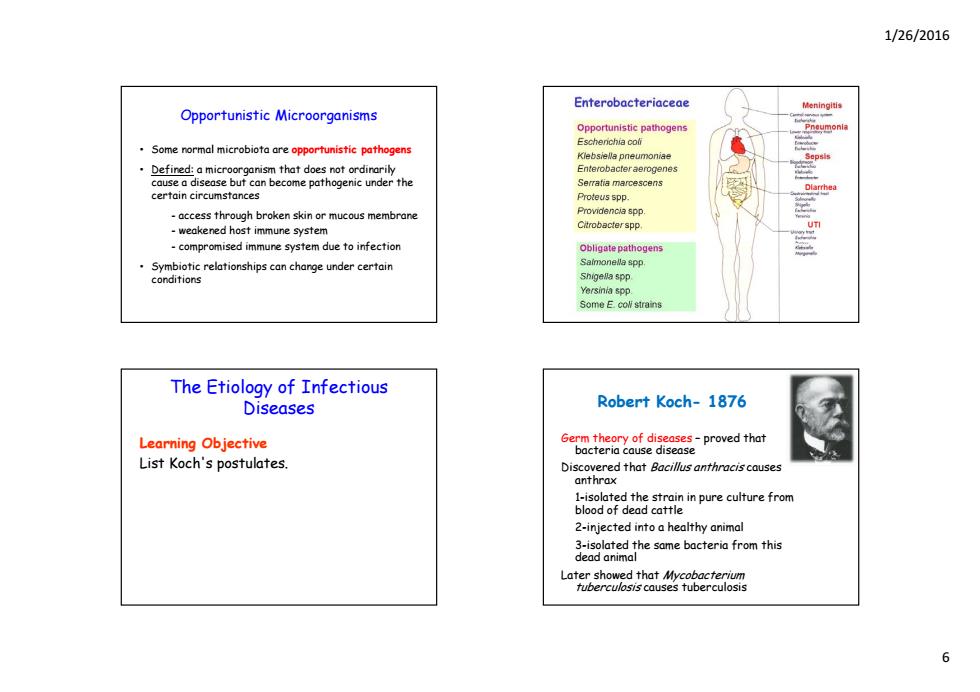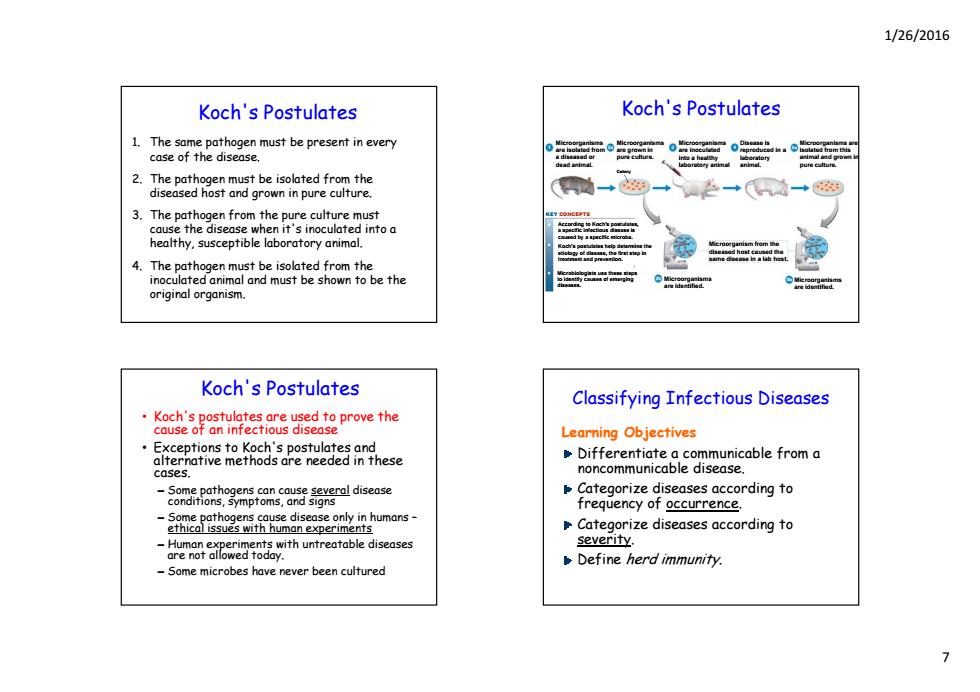
1/26/2016 Enterobacteriaceae Opportunistic Microorganisms Opportunistic pathogens Eschenchia col Some normal microbiota are opportunistic pathogens Klebsiella pneumoniae cause a dis r the Serratia marcescens certain circumstances Proteus spp. access through broken skin or mucous membrane Providencia spp. weakened host immune system -compromised immune system due to infection Obligate pathogens Symbiotic relationships can change under certain Saimonella spp. conditions Shigella spp Yersinia spp Some E coW strains The Etiology of Infectious Diseases Robert Koch-1876 Learning Objective List Koch's postulates. Discovered that Bacillus anthracis causes anthrax 1-isolated the strain in pure culture from blood of dead cattle 2-injected into a healthy animal 3-isolated the same bacteria from this dead animal latb2eweetatsRbeterosg tuber 6
1/26/2016 6 Opportunistic Microorganisms • Some normal microbiota are opportunistic pathogens • Defined: a microorganism that does not ordinarily cause a disease but can become pathogenic under the certain circumstances - access through broken skin or mucous membrane - weakened host immune system - compromis d i s st d t i f ti ised immune system due to infection • Symbiotic relationships can change under certain conditions The Etiology of Infectious Diseases Learning Objective List Koch's postulates. Robert Koch- 1876 Germ theory of diseases – proved that b t i s dis s bacteria cause disease Discovered that Bacillus anthracis causes anthrax 1-isolated the strain in pure culture from blood of dead cattle 2-injected into a healthy animal 3-isolated the same bacteria from this dead animal Later showed that Mycobacterium tuberculosis causes tuberculosis

1/26/2016 Koch's Postulates Koch's Postulates 1.The same pathogen must be present in every case of the disease. 2.The pathogen must be isolated from the diseased host and grown in pure culture. 3.The pathogen from the pure culture must cause the disease when it's inoculated into a healthy.susceptible laboratory animal. 4.The pathogen must be isolated from the inoculated animal and must be shown to be the 2 original organism. Koch's Postulates Classifying Infectious Diseases Koch's postulates are used to prove the cause of an infectious disease Learning Objectives Exceptions to Koch's postulates and alternative methods are needed in these Differentiate a communicable from a cases. noncommunicable disease. -Some pathogens can cause several disease Categorize diseases according to conditions,symptoms,and signs frequency of occurrence. Categorize diseases according to -tenreieeaf8ayrthuntreatobedseascs severity. Define herd immunity. Some microbes have never been cultured
1/26/2016 7 Koch's Postulates 1. The same pathogen must be present in every case of the disease. 2. The pathogen must be isolated from the diseased host and grown in pure culture. 3. The pathogen from the pure culture must cause the disease when it's inoculated into a healthy susceptible laboratory animal healthy, susceptible laboratory animal. 4. The pathogen must be isolated from the inoculated animal and must be shown to be the original organism. Microorganisms are isolated from a diseased or dead animal Microorganisms are grown in pure culture. Microorganisms are inoculated into a healthy laboratory animal Disease is reproduced in a laboratory animal Microorganisms are isolated from this animal and grown in pure culture Koch's Postulates KEY CONCEPTS dead animal. laboratory animal animal. pure culture. Colony Microorganism from the According to Koch's postulates, a specific infectious disease is caused by a specific microbe. from the diseased host caused the same disease in a lab host. Microorganisms are identified. Microorganisms are identified. Microbiologists use these steps to identify causes of emerging diseases. Koch's postulates help determine the etiology of disease, the first step in treatment and prevention. Koch's Postulates • Koch's postulates are used to prove the cause of an infectious disease • Exceptions to Koch's postulates and alternative methods are needed in these cases. – Some pathogens can cause several disease conditions, symptoms, and signs – Some pathogens cause disease only in humans – ethical issues with human experiments – Human experiments with untreatable diseases are not allowed today. – Some microbes have never been cultured Classifying Infectious Diseases Learning Objectives Diff i i bl f Differentiate a communicable from a noncommunicable disease. Categorize diseases according to frequency of occurrence. Categorize diseases according to severity. Define herd immunity